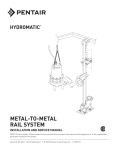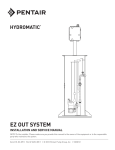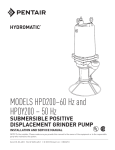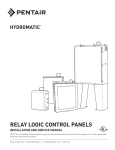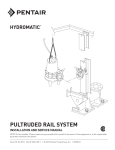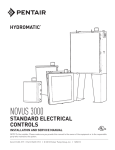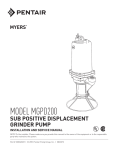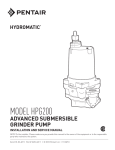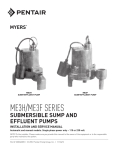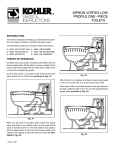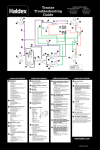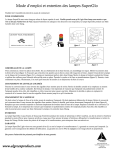Download MODEL SPC-PANEL - Pentair Water Literature
Transcript
MODEL SPC-PANEL Pump Controls for 2 HP Grinder Pumps SIMPLEX, SINGLE PHASE PUMP CONTROL PANEL INSTALLATION AND SERVICE MANUAL NOTE! To the installer: Please make sure you provide this manual to the owner of the equipment or to the responsible party who maintains the system. Item # E-03-352 | Part # 5625-352-1 | © 2012 Pentair Pump Group, Inc. | 10/29/12 CALIFORNIA PROPOSITION General65 WARNING: Information This Thank you for purchasing your Hydromatic® control panel. To help ensure years of troublefree op er a tion, please read the following manual carefully. Before Operation: Read the following in struc tions care ful ly. Reasonable care and safe meth ods should be practiced. Check local codes and requirements before installation. Attention: This manual contains important information for the safe use of this product. Read this manual completely before using this product and refer to it often for con tin ued safe product use. DO NOT THROW AWAY OR LOSE THIS MAN U AL. Keep it in a safe place so that you may refer to it when needed. Unpacking Panel: Remove panel from carton. When unpacking unit, check for con cealed damage. Claims for damage must be made at the receiving end through the delivery carrier. Dam age cannot be processed from the factory. WARNING: Before handling these Hydromatic pumps and controls, always disconnect the power first. Do not smoke or use sparkable electrical devices or flames in a septic (gaseous) or possible septic sump. 2 product and related accessories contain chemicals known to the State of California to cause cancer, birth defects or other reproductive harm. Panel Installation Electrical Connections: The contractor must conform to the latest requirements of the National Electrical Code. All conduit and ca bles shall be in accordance with NEC code NFPA #70. To maintain UL type 4X and CSA ENCL 4 rating, use UL type 4 and CSA weatherproof conduit hubs when connecting to this enclosure. Prior to conducting any installation, repair or service with regard to the control panel, refer to the schematic appropriate for that panel. The schematic will provide guidance with regard to the terminal block connections. CAUTION: Nonmetallic enclosures do not provide grounding conduit connections. Use grounding bush ing and jumper wires. Make the Following Electrical Connections: a.Connect the pump leads to the control panel. When connecting the pump leads it is very critical that the proper sequence be maintained. On single phase pumps, the color coded pump leads black, white, red, must be connected to the appropriate terminals as directed by the control schematic. b. Connect the pump heat sensor and seal failure leads (if available on the pump) to the appropriate terminal blocks in the control panel. If the heat sensor lead from the pump is wired as indicated, remove jumpers as defined by the schematic. c.Connect all the float control leads to the appropriate panel terminal blocks. Con trac tor must be very careful in locating the floats at the proper elevations. The maximum distance from the control panel and the floats is the lesser of l00 feet, or the maximum distance recommended for the pump. d.Before connecting power to the control panel, make sure all the control switches (e.g. H-O-A switch) and protective devices (e.g. breakers) are in the Off position. Now connect power to the circuit breaker as directed by the schematic. e.Power must be the correct voltage for the pump model. Power must have neutral to supply 120 volts to the control circuit. f. Control panel must be grounded properly per NEC and/or local codes. To facilitate this, a ground lug is provided on the control panel. Panel Operations WARNING: Before handling these Hydromatic pumps and controls, always disconnect the power first. Do not smoke or use sparkable electrical devices or flames in a septic (gaseous) or possible septic sump. Check List: 1. Check junction box for moisture. 2. Check wiring of pump black, white, red power wires. 3. Check wiring of heat sensor and seal failure wires if supplied. 4. Energize control panel. (Turn on power to panel.) 5. Check overload relay and verify reset mode (if overload is supplied). 6. WARNING! Live voltage can kill! Check voltage to the panel and to the control circuit using a voltmeter. 7. Check float operation and response to control panel to the float operation. For sequence of operation, refer to design specification. 8. Check full load current with amp probe and compare it with the nameplate rating. (Clamp amp probe around black pump wire.) 9. With pump running, check discharge to verify the pump is running. Check for flow. 10.Check operation of start relay, per procedure in Item #3 on page 4. 11. Make sure H-O-A switch is left in the Auto position after start-up is completed. 12.Make sure all conduits from wet well to panel are sealed below panel. Septic gases will damage components in panel. Pump Start-up: Refer to pump “Installation and Service Manual”. Panel Maintenance WARNING: Before handling these Hydromatic pumps and controls, always disconnect the power first. Do not smoke or use sparkable electrical devices or flames in a septic (gaseous) or possible septic sump. 1.Pump does not run in Hand position. a. Check pump circuit breaker and control fuse for tripping or blown condition. b.Check incoming power voltage and control circuit voltage. c. Check overload relay to see if it is tripped. Reset relay if tripped. d.With the power off, check motor heat sensor continuity. e.Check wiring of pump to control panel. It should agree with the schematic. f. Check contactor coil resistance. It should be 50 to 200 ohms. 2.Pump does not run in Auto position. a.Check items (a.) through (d.) per Item #1. b. Floats may be miswired to control panel. Check float type (N.O. or N.C.) and hook up by referring to the schematic. If the start and stop floats are hooked in reverse, pump will short cycle and will not pump the level down. c.Is the water level in the system high enough to activate floats? d1. With the power off, remove Off float and On float wires and replace with two jumpers made from insulated wire. d2.Turn power on (with H-O-A switch in Auto position). If pump runs, the problem is in one of the floats. d3.If the problem is in a float, turn power off, remove jumper and reconnect the upper float. Turn power on and see if pump will run in Auto. This will help identify which float is the problem. Turn power off before removing any jumper or reconnecting any float. 3.Pump runs, but run light does not energize. a.Remove light bulb and check with ohmmeter. b.Check wiring for run light in panel. 4.Pump runs but does not pump down the wet well. a.Impeller may be dragging in volute due to solids. High amperage draw would identify this. b.Refer to the pump manual for other possibilities such as closed discharge gate valve, etc. 5. Severe humming/chattering of contactors and control relays. a. There may be low voltage. Check voltage to the panel and to the control circuit using a voltmeter. This low voltage condition may even cause severe chattering and burn-out of relays. Contactors require a minimum of 85% of full 3 Panel Maintenance vol tage to pull in without chatter. If the problem is a recurring one, measure voltage with recorder on a 24 hour basis. b.Contactor may have dust around magnet of coil struc ture. Dry or clean as required. c. Make sure the floats are located away from any turbulence. d.Dry out the junction box (if furnished); moisture in the junction box may tend to cause relays to energize intermittently. 6. Nuisance tripping of overload on motor starters or circuit breakers. a. Check all reset buttons and tripped breakers. b. Check pump amp draw with amp probe and compare to nameplate amps on pump. c. The impeller may be locked up due to excessive debris or solids. d. Possible motor failure (fault on windings). e. Pump may be miswired to terminal blocks. 7. Short cycling pump. a. Check float controls. 8. Run light stays on. a.Selector switch may be in the Hand position. 4 9. Test for blown fuse. a. Check for continuity with a V-O-M set on ohm scale. Single Phase Pump Only: Connections and start components WARNING: Disconnect all power from the panel before making these checks. 1.Motor winding resistance readings. a. Disconnect all three motor leads. b.Using a volt-ohm meter, with the scale set on RX1, measure the resistance between the leads with the following chart. Typical MotorResistance WindingLeads Reading Main Black to Lowest White Start Black to Next Red Lowest (Middle) Both White to Highest Red 2. Capacitor Check. a.Make sure the capacitors are discharged. Use extreme caution; severe shock hazard may exist with capacitors. b.Disconnect the capacitor leads and connect a volt-ohmmeter to the capacitor terminals. c.The meter should indicate low ohms when it is first connected, but as the capacitor becomes charged (by the meter), it will return to a reading of infinity (open circuit). NOTE: Set the meter on the RX10,000 scale to check the run capacitor. Set the meter on the RX1,000 scale to check the start capacitor. 3. Start relay check. a. With power off, check the start relay coil resistance. It should be 3000 to 7000 ohms. b.Turn power on and run pump in Hand position. After the pump starts, check the voltage from terminal 1 to terminal 2 on the start relay to be sure that the relay has operated. The voltage from terminal 1 to terminal 2 on the start relay must exceed 10 VAC. For some pumps the voltage may exceed 400 VAC. If after 5 seconds the voltage from terminal 1 to terminal 2 on the start relay does not exceed 10 VAC, stop the pump as damage to the start capacitor will occur in about 15 seconds. If the start relay is not operating, check the pump and the system voltage to be sure that they match. Check the power wiring to ensure that the pump is connected properly. Start the pump once more and check to see if the voltage from the terminal for the black wire to the white wire is within system tolerance. Call for help if you cannot resolve the problem. THIS PAGE INTENTIONALLY LEFT BLANK THIS PAGE INTENTIONALLY LEFT BLANK THIS PAGE INTENTIONALLY LEFT BLANK STANDARD LIMITED WARRANTY Pentair Hydromatic® warrants its products against defects in material and workmanship for a period of 12 months from the date of shipment from Pentair Hydromatic or 18 months from the manufacturing date, whichever occurs first – provided that such products are used in compliance with the requirements of the Pentair Hydromatic catalog and technical manuals for use in pumping raw sewage, municipal wastewater or similar, abrasive-free, noncorrosive liquids. During the warranty period and subject to the conditions set forth, Pentair Hydromatic, at its discretion, will repair or replace to the original user, the parts that prove defective in materials and workmanship. Pentair Hydromatic reserves the right to change or improve its products or any portions thereof without being obligated to provide such a change or improvement for prior sold and/or shipped units. Start-up reports and electrical schematics may be required to support warranty claims. Submit at the time of start up through the Pentair Hydromatic website: http://forms.pentairliterature.com/startupform/startupform.asp?type=h. Warranty is effective only if Pentair Hydromatic authorized control panels are used. All seal fail and heat sensing devices must be hooked up, functional and monitored or this warranty will be void. Pentair Hydromatic will cover only the lower seal and labor thereof for all dual seal pumps. Under no circumstance will Pentair Hydromatic be responsible for the cost of field labor, travel expenses, rented equipment, removal/reinstallation costs or freight expenses to and from the factory or an authorized Pentair Hydromatic service facility. This limited warranty will not apply: (a) to defects or malfunctions resulting from failure to properly install, operate or maintain the unit in accordance with the printed instructions provided; (b) to failures resulting from abuse, accident or negligence; (c) to normal maintenance services and parts used in connection with such service; (d) to units that are not installed in accordance with applicable local codes, ordinances and good trade practices; (e) if the unit is moved from its original installation location; (f) if unit is used for purposes other than for what it is designed and manufactured; (g) to any unit that has been repaired or altered by anyone other than Pentair Hydromatic or an authorized Pentair Hydromatic service provider; (h) to any unit that has been repaired using non factory specified/ OEM parts. Warranty Exclusions: Pentair HYDROMATIC MAKES NO EXPRESS OR IMPLIED WARRANTIES THAT EXTEND BEYOND THE DESCRIPTION ON THE FACE HEREOF. Pentair HYDROMATIC SPECIFICALLY DISCLAIMS THE IMPLIED WARRANTIES OF MERCHANTABILITY AND FITNESS FOR ANY PARTICULAR PURPOSE. Liability Limitation: IN NO EVENT SHALL Pentair HYDROMATIC BE LIABLE OR RESPONSIBLE FOR CONSEQUENTIAL, INCIDENTAL OR SPECIAL DAMAGES RESULTING FROM OR RELATED IN ANY MANNER TO ANY Pentair HYDROMATIC PRODUCT OR PARTS THEREOF. PERSONAL INJURY AND/OR PROPERTY DAMAGE MAY RESULT FROM IMPROPER INSTALLATION. Pentair HYDROMATIC DISCLAIMS ALL LIABILITY, INCLUDING LIABILITY UNDER THIS WARRANTY, FOR IMPROPER INSTALLATION. Pentair HYDROMATIC RECOMMENDS INSTALLATION BY PROFESSIONALS. Some states do not permit some or all of the above warranty limitations or the exclusion or limitation of incidental or consequential damages and therefore such limitations may not apply to you. No warranties or representations at any time made by any representatives of Pentair Hydromatic shall vary or expand the provision hereof. 740 EAST 9TH STREET 490 Pinebush Road, Unit #4 ASHLAND, OHIO, USA 44805 CAMBRIDGE, ONTARIO, CANADA N1T 0A5 419-289-1144800-363-PUMP WWW.HYDROMATIC.COM Warranty Rev. 12/13








